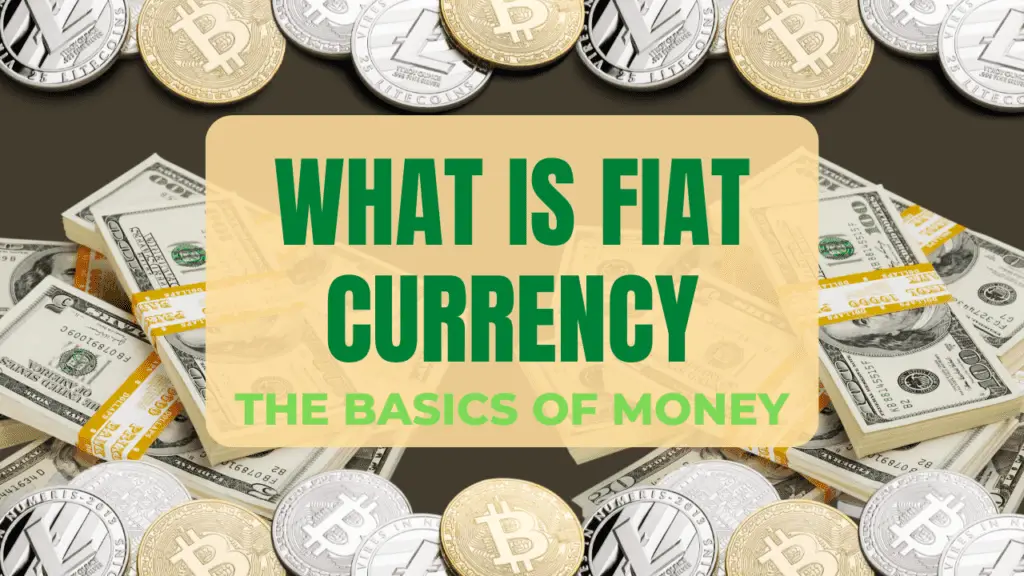In today’s world, money can come in many forms. It usually has some sort of value that we can trade for goods or services. The type of money we use often depends on the country or region we are living in. There are many different types of money. Each has its advantages and disadvantages depending on your personal situation and preferences.
Although this may not be important to a majority of the followers, it is important for investors to understand how money works so that they know better how they should be handling their money. In this article, we will explore what fiat currency is and why it’s so commonly used as currency today. Let’s begin by exploring what money is and how it comes in different forms.
What is Money?
Money is a commonly used medium of exchange. It can be anything that can be used to purchase goods and services. If a medium is widely accepted and has a consistent value, it usually becomes a form of money. Throughout history, many different commodities have been used as money. Some examples include gold and silver, grain, cattle, and even seashells.
In the olden days, we trade cattle with one another as a form of money transfer. In more modern economies, we use representative money instead. Representative money has no inherent value on its own. It is the promise of an equivalent amount of commodity money that backs the value of the money. Fiat currency is the most common form of representative money in the world today.
Commodity Money
Commodity money is a physical item that has value. It can be traded for goods and services. The commodity is usually rare and limited in supply, making it a reliable store of value and medium of exchange. Goods that were often used as commodity money include silver, gold, and grain. Commodity money is a type of money where the medium of exchange is a valuable commodity that has intrinsic value. The commodity can be used for trade or it can be traded for other commodities or services. Some examples of commodity money are gold, silver, and copper coins. Commodity money comes in many different forms. It can be in the form of a bar or a coin. It can be in the form of a block of gold or silver.
Representative Money
Representative money is a form of money that has no intrinsic value. It is backed by an equivalent amount of commodity money, such as gold or silver, that is kept in a central bank or government vault. It is much easier for governments and banks to produce paper money than gold or silver coins. This makes it a more efficient way to exchange and store value. The paper money promises to pay the equivalent amount of gold or silver on demand. It provides a different form of value than commodity money.
This is how representative money differs from commodity money. It is backed by an equivalent amount of commodity money, such as gold or silver, that is kept in a central bank or government vault. It is much easier for governments and banks to produce paper money than gold or silver coins. This makes it a more efficient way to exchange and store value. The paper money promises to pay the equivalent amount of gold or silver on demand. This is the difference between commodity and representative money.
Fiat Currency
Fiat currency is a form of representative money that does not tie its value to gold or silver. It is called fiat because the value of the money is based on a government mandate that makes it legal tender. Fiat currency is commonly used today for paper money. The value of fiat currency is the promise that it will be redeemed for an equivalent amount of commodities, such as gold or silver, on demand. Therefore, the currency is backed by nothing except the promise that there is an equivalent amount of commodities behind it.
Why Is Fiat Currency So Common?
A government mandates that the currency is legal tender. This means it is the only form of money that can be used to pay taxes and other government debts. Fiat money gives governments more freedom to control their own currencies, establish monetary policy, and maintain market stability. It also means that citizens must use fiat currency for any financial transactions. It is easy for a government to mandate that its citizens use its fiat currency. This is because it does not require the government to produce enough gold or silver to back up the fiat currency it prints. Additionally, it permits fractional reserve banking, which enables commercial banks to increase their cash reserves
Fiat currency is often printed with special security features. This helps to protect it from counterfeiting. A government can print as much fiat currency as it wants. This makes it easy for the government to create new money and increase the supply of money in the economy. This can cause significant inflation in the economy if not controlled by the government. The government can also use the fiat currency to stimulate economic growth. It can do this by lowering interest rates and increasing the supply of money.
The Problem with Fiat Currency
Fiat currency has no intrinsic value. It is the promise of a government that it will be exchanged for commodities, such as gold or silver, on demand. If a government fails to back the value of its currency with commodities, it causes inflation in the economy. Inflation occurs when the supply of money in the economy increases faster than the demand for goods and services.
This causes commodities to rise in price. It makes fiat currency worth less in terms of goods. If a government fails to back the value of its fiat currency, it causes inflation in the economy. Inflation occurs when the supply of money in the economy increases faster than the demand for goods and services. This causes commodities to rise in price. It makes fiat currency worth less in terms of goods. The value of the fiat currency falls because no one wants to hold onto a depreciating form of money. This can lead to a serious economic crisis.
Hyperinflation
When a nation prints its own money, there is always the chance of hyperinflation. However, the majority of developed nations have only seen mild inflationary episodes. In fact, maintaining a consistently low level of inflation is thought to be a good thing for investment and economic growth because it encourages people to use their money instead of letting it sit around and gradually lose purchasing power.
Most modern central banks are required to maintain relatively strong and stable currencies, and a rapidly depreciating currency is detrimental to financing and trade. Furthermore, it is not clear whether “runaway printing” of money contributes to hyperinflation or not. In fact, hyperinflation has always happened, even when currencies were based on precious metals. All recent instances of hyperinflation have started with a fundamental breakdown in the real production economy and/or a nation’s political unrest.
Countries such as Turkey and Venezuela are names that you would hear of when it comes to countries that have faced the worst of hyperinflation. Turkey’s inflation rate rose to 85.5% in October 2022 while Venezuela
Summing up
Money is a commonly used medium of exchange. It can be anything that can be used to purchase goods and services. There are many different types of money. Commodity money is a physical item that has value. Representative money has no inherent value. Fiat currency is backed by a government mandate that it is used as legal tender. Fiat currency has no intrinsic value because it is backed by nothing. This makes it very easy for governments to print more money. This can cause significant inflation in the economy. Therefore, the government needs to have a good understanding on controlling inflation and keeping it with the 2% inflation rate.





